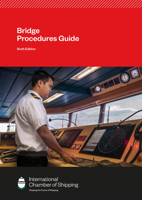Bridge Procedures
Passage Planning Guide, Baltic: Danish Straits - (PPG - Baltic, 2025-26 Edition)
£292.50 £325.00
This publication is an essential resource for ships navigating the Danish Straits and provides guidance to aid Masters and navigating officers in the creation of passage plans for the transit. The guidance applies in either direction through the Straits via the Great Belt and the Sound and includes an overview of the navigational references for each leg of the routes. In cooperation with DanPilot and BIMCO, this new edition has been fully revised to incorporate the latest guidance and practical advice for ships transiting the region, with reference to important information such as pilotage, anchorages, reporting requirements and traffic.
Passage Planning Guidelines, 2025 Edition
£292.50 £325.00
Stock due in April 2025. Passage Planning Guidelines 2025 - (Incorporating Radar and ARPA, Safe Nav Watch and Teamwork on the Nav Bridge)
Passage Planning Guide – Straits of Malacca and Singapore (SOMS) (PPG – SOMS 2025-26 Edition)
£292.50 £325.00
This publication provides passage planning guidance for Masters and navigating officers when transiting the Straits of Malacca and Singapore. This new edition has been fully revised to incorporate the latest guidance and practical advice for ships transiting the region, with reference to high vigilance areas, Straits Pilot Services, TSS and VTS information
Passage Planning Guide - English Channel, Dover Strait and Southern North Sea - 2024-25 Edition
£292.50 £325.00
This Guide is an essential resource for any ship navigating the English Channel, Dover Strait and Southern North Sea. Published in conjunction with the UK Chamber of Shipping, it contains passage planning information and the latest navigational guidance and practical advice for the region. It includes full-colour, pull-out chartlets, details of traffic hotspots and main ferry routes, weather and tidal information, and TSS and VTS information.
Passage Planning Guide: Great Barrier Reef and Torres Strait - (PPG - GBRTS 2023-24 Edition)
£292.50 £325.00
This publication has been revised to incorporate the latest guidance and practical advice for ships transiting the Great Barrier Reef and Torres Strait. All the data contained within this Guide has been reviewed and validated by Auriga Pilots, drawing on their considerable experience in all areas of the Marine Park and beyond.
The Master's Practical Guide to Maritime Law
£225.00 £250.00
This first edition of The Master’s Practical Guide to Maritime Law is a comprehensive, easy to follow guide written specifically for Masters.
Passage Planning Guidelines, 2023 Edition
£265.50 £295.00
New edition is coming April 2025
Bell Book for Bridge or Engine Movements
£35.39
A high quality semi-hard cover Bell Book for recording engine movements and other observations on the Bridge or in the Engine Room. 192 numbered pages, dimensions 30cm x 14cm
Guidelines on the IMO STCW Convention, 4th Edition
£126.00 £140.00
The fourth edition of Guidelines on the IMO STCW Convention sets out the obligations for shipping companies and includes guidance on how to ensure compliance on board.
Chief Officer's Log Book - Clutha - 6 months
£36.25
The Brown Son and Ferguson 'Clutha' logbook for Chief Officers allows the recording of one day's work per page. This edition is fit for 6 months work.
ICS Bridge Procedures Guide 6th Edition, 2022
£153.00 £170.00



































